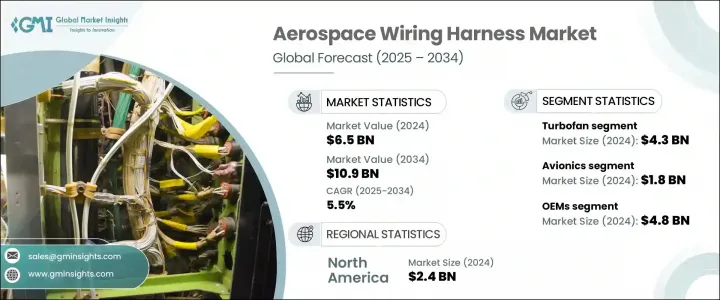
|
시장보고서
상품코드
1797778
항공우주용 와이어링 하니스 시장 기회, 성장 촉진요인, 산업 동향 분석 및 예측(2025-2034년)Aerospace Wiring Harness Market Opportunity, Growth Drivers, Industry Trend Analysis, and Forecast 2025 - 2034 |
||||||
세계의 항공우주용 와이어링 하니스 시장 규모는 2024년에 65억 달러로 평가되었고, CAGR 5.5%를 나타내 2034년에는 109억 달러에 이를 것으로 예측되고 있습니다.
이 확대를 촉진하는 주요 요인으로는 항공기 제조의 급증, 항공우주 시스템의 전동화의 진전, 방위 항공 수요 증가, 정비·수리·오버홀 서비스의 요구 증가 등이 있습니다. 유행 후 세계의 항공 여행의 회복에 의해 여객·화물 양쪽의 운항으로 항공기의 증비가 급증하고 있습니다. ICAO, FAA, EASA 등의 규제기관도 고신뢰성, 경량, 내화성 배선 시스템을 요구하는 엄격한 컴플라이언스 조치를 실시했습니다. 이러한 규칙은 AS/EN 9100 표준을 준수하는 항공우주 등급 재료의 채택을 가속화합니다. 또한, 항공 분야에서는 아크폴트 검출이나 내화성/내연성이 중시되기 때문에 실드 하네스나 난연성 도관 시스템에 대한 요구가 크게 높아지고 있으며, 시장의 성장을 더욱 뒷받침하고 있습니다.

항공기 기술의 전동화와 안전 중심으로의 이동으로 OEM과 공급업체는 가혹한 조건을 견디고 중요한 환경에서 안정적인 성능을 발휘할 수 있는 와이어링 하니스 설계를 혁신할 필요가 있습니다. 항공기 시스템의 복잡화와 전력 집약화에 따라 경량 컴팩트하고 열에 강한 하네스에 대한 수요가 높아지고 있습니다. 이러한 하네스는 최소한의 무게와 최대의 효율성을 보장하면서 고급 바이오닉스, 비행 제어 시스템, 점점 더 전동화되는 추진 기술을 지원해야 합니다. 항공기의 전동화(MEA)를 향한 움직임은 이 변화를 더욱 가속화하고 있으며, 보다 높은 전압 부하에 대응하고 다양한 서브시스템에 전력을 확실하게 분배할 수 있는 하네스가 요구되고 있습니다.
| 시장 범위 | |
|---|---|
| 시작 연도 | 2024년 |
| 예측 연도 | 2025-2034년 |
| 시작 금액 | 65억 달러 |
| 예측 금액 | 109억 달러 |
| CAGR | 5.5% |
2024년 터보팬 엔진 분야의 매출은 43억 달러였습니다. 에너지 효율적이고 친환경 항공기를 추구하는 움직임은 복잡한 전자 시스템을 위한 고급 와이어링 하니스를 필요로 하는 기어드 터보 팬 엔진의 통합을 뒷받침하고 있습니다. 또한 주요 국가의 국방 지출은 첨단 전투기 프로그램을 뒷받침하고 운영 신뢰성을 높이기 위해 전자기 간섭과 극단적인 온도에 대한 높은 내성을 갖춘 하네스 솔루션의 필요성을 높이고 있습니다. 그 결과, 항공우주용 와이어링 하니스 제조업체는 군용기와 차세대 제트기의 요건을 충족하기 위해 내구성이 뛰어난 고성능 제품의 개발을 점점 더 진행하고 있습니다.
배전 시스템 분야는 2034년까지 연평균 복합 성장률(CAGR) 7.6%를 나타낼 전망입니다. 항공기의 전동화를 위한 업계의 움직임은 보다 큰 전기 부하를 관리하고 항공기의 성능을 효율화할 수 있는 고도로 효율적인 배전 하네스 수요를 촉진하고 있습니다. 최신 항공기 플랫폼은 원활한 전기 전송이 가능한 고출력 하네스가 필요하며 유압 시스템 및 기계 시스템을 전기 부품으로 점차 교체하는 업계를 지원합니다.
2024년 북미의 항공우주용 와이어링 하니스 시장 규모는 24억 달러를 기록했습니다. 이러한 이점은 차세대 항공기 개발과 고급 전기화 프로그램에 대한 왕성한 투자 때문입니다. 정부 및 민간 항공우주 이니셔티브의 엄청난 기여로 엄격한 성능 기대에 부응하도록 조정된 특수 고전압 하네스 기술에 대한 요구가 커지고 있습니다. 이 지역의 항공 기술 혁신에 대한 적극적인 노력은 이 시장의 성장 궤도에 크게 기여합니다.
주요 시장 진출 기업으로는 Heritage Aviation, Amphenol Corporation, InterConnect Wiring, HTL, Latecoere, VezeWire, Unicor, Cloom Tech, Ametek, Herber Aircraft Service, GKN Aerospace, Miracle Electronics Devices, Safran, TE Connectivity, Collins Aerospace 등이 있습니다. 이러한 기업들은 혁신과 비즈니스 규모를 확대함으로써 시장의 발자국을 지속적으로 강화하기 위해 노력하고 있습니다. 항공우주용 와이어링 하니스 업계의 주요 기업은 시장에서의 지위를 강화하기 위해 혁신, 커스터마이즈 및 전략적 확장을 결합하여 채택하고 있습니다. 많은 기업들은 연료 효율이 높고 보다 안전한 항공기에 대한 규제 및 운영 요구를 충족시키기 위해 첨단 소재 및 경량화 솔루션에 투자하고 있습니다. 또한 민간 및 방어 항공 플랫폼을 위해 설계된 고온 및 EMI 실드 하네스에 중점을 둡니다. 제조업체는 항공기 OEM 및 방위 관련 기업과의 전략적 제휴 및 협력을 통해 세계적인 사업 전개를 진행하고 있습니다. 특정 항공기 모델과 미션 크리티컬 시스템에 맞는 맞춤형 디자인의 와이어링 하니스가 우선 과제입니다.
목차
제1장 조사 방법과 범위
제2장 주요 요약
제3장 업계 인사이트
- 생태계 분석
- 공급자의 상황
- 이익률
- 비용 구조
- 각 단계에서의 부가가치
- 밸류체인에 영향을 주는 요인
- 파괴적 혁신
- 생태계 분석
- 업계에 미치는 영향요인
- 성장 촉진요인
- 항공기 생산 증가
- 엄격한 안전규제
- 항공기 시스템의 전동화
- 군용 항공의 성장
- 보수, 수리, 오버홀(MRO) 활동
- 함정과 과제
- 높은 재료비
- 공급망의 혼란
- 성장 촉진요인
- 성장 가능성 분석
- 규제 상황
- 북미
- 유럽
- 아시아태평양
- 라틴아메리카
- 중동 및 아프리카
- Porter's Five Forces 분석
- PESTEL 분석
- 기술과 혁신의 상황
- 현재의 기술 동향
- 신흥기술
- 가격 동향
- 지역별
- 제품별
- 가격 전략
- 새로운 비즈니스 모델
- 컴플라이언스 요건
- 국방예산 분석
- 세계의 방위비의 동향
- 지역 방위 예산 배분
- 북미
- 유럽
- 아시아태평양
- 중동 및 아프리카
- 라틴아메리카
- 주요 방위 근대화 프로그램
- 예산 예측(2025-2034년)
- 업계의 성장에 미치는 영향
- 국가별 방위 예산
- 지속가능성에 대한 노력
- 공급 체인의 탄력
- 지정학적 분석
- 인재 분석
- 디지털 변혁
- 합병, 인수, 전략적 파트너십의 상황
- 위험 평가 및 관리
- 주요 계약 체결(2021-2024년)
제4장 경쟁 구도
- 서론
- 기업의 시장 점유율 분석
- 지역별
- 북미
- 유럽
- 아시아태평양
- 라틴아메리카
- 중동 및 아프리카
- 시장 집중 분석
- 지역별
- 주요 기업의 경쟁 벤치마킹
- 재무실적의 비교
- 수익
- 이익률
- 연구개발
- 제품 포트폴리오 비교
- 제품 라인업의 넓이
- 기술
- 파괴적 혁신
- 지리적 존재의 비교
- 세계 실적 분석
- 서비스 네트워크의 범위
- 지역별 시장 침투율
- 경쟁 포지셔닝 매트릭스
- 리더들
- 과제자들
- 팔로워
- 틈새 기업
- 전략적 전망 매트릭스
- 재무실적의 비교
- 주요 발전(2021-2024년)
- 합병과 인수
- 파트너십 및 협업
- 기술적 진보
- 확대 및 투자 전략
- 지속가능성에 대한 노력
- 디지털 변혁의 대처
- 신흥기업/스타트업기업경쟁 구도
제5장 시장 추계·예측 : 기종별(2021-2034년)
- 주요 동향
- 터보팬
- 터보제트
- 터보프롭
- 터보샤프트
- 무인 항공기
- VTOL
제6장 시장 추계·예측 : 용도별(2021-2034년)
- 주요 동향
- 항공전자기기
- 전력 분배
- 비행 제어 시스템
- 조명 시스템
- 엔진 및 추진 시스템
- 객실 인테리어 및 기내 엔터테인먼트(IFE)
- 랜딩기어 시스템
- 기타
제7장 시장 추계·예측 : 최종 용도별(2021-2034년)
- 주요 동향
- OEM
- 애프터마켓
제8장 시장 추계·예측 : 지역별(2021-2034년)
- 주요 동향
- 북미
- 미국
- 캐나다
- 유럽
- 독일
- 영국
- 프랑스
- 스페인
- 이탈리아
- 네덜란드
- 아시아태평양
- 중국
- 인도
- 일본
- 호주
- 한국
- 라틴아메리카
- 브라질
- 멕시코
- 아르헨티나
- 중동 및 아프리카
- 사우디아라비아
- 남아프리카
- 아랍에미리트(UAE)
제9장 기업 프로파일
- AMETEK, Inc.
- Amphenol Corporation
- Cloom Tech
- Collins Aerospace
- GKN Aerospace
- Glenair, Inc.
- Herber Aircraft Service
- Heritage Aviation, Ltd
- HTL Ltd.
- InterConnect Wiring
- kSARIA Corporation
- Latecoere
- Miracle Electronics Devices Pvt Ltd.
- Omega Leads, Inc.
- Safran SA
- Senra Systems
- TE Connectivity plc
- UNICOR
- VezeWire
The Global Aerospace Wiring Harness Market was valued at USD 6.5 billion in 2024 and is estimated to grow at a CAGR of 5.5% to reach USD 10.9 billion by 2034. Key factors driving this expansion include a surge in aircraft manufacturing, rising electrification in aerospace systems, increasing demand in defense aviation, and the growing need for maintenance, repair, and overhaul services. Post-pandemic recovery in global air travel has led to a sharp rise in fleet expansion for both passenger and cargo operations. Regulatory bodies such as ICAO, FAA, and EASA are also enforcing strict compliance measures requiring highly reliable, lightweight, and fire-resistant wiring systems. These rules are accelerating the adoption of aerospace-grade materials compliant with AS/EN 9100 standards. Moreover, as the aviation sector emphasizes arc fault detection and fire/smoke resistance, the requirement for shielded harnesses and fire-retardant conduit systems is significantly increasing, further fueling market growth.

The shift toward electrified and safety-centric aircraft technologies is pushing OEMs and suppliers to innovate wiring harness designs that can withstand extreme conditions and provide consistent performance in critical environments. As aircraft systems become more complex and power-intensive, the demand for lightweight, compact, and thermally resilient harnesses is escalating. These harnesses must support advanced avionics, flight control systems, and increasingly electrified propulsion technologies, all while ensuring minimal weight and maximum efficiency. The move toward more electric aircraft (MEA) is further accelerating this transformation, requiring harnesses capable of handling higher voltage loads and distributing power reliably across various subsystems.
| Market Scope | |
|---|---|
| Start Year | 2024 |
| Forecast Year | 2025-2034 |
| Start Value | $6.5 billion |
| Forecast Value | $10.9 billion |
| CAGR | 5.5% |
In 2024, the turbofan engine segment generated USD 4.3 billion. The push for energy-efficient and environmentally friendly aircraft has driven the integration of geared turbofan engines, which demand sophisticated wiring harnesses for complex electronic systems. Defense spending by major countries is also favoring advanced combat aircraft programs, boosting the need for harness solutions with high resistance to electromagnetic interference and extreme temperatures for operational reliability. As a result, aerospace wiring harness manufacturers are increasingly developing durable, high-performance products to meet military and next-generation jet requirements.
The power distribution systems segment will grow at a CAGR of 7.6% through 2034. The industry's move toward more electric aircraft is driving demand for advanced, efficient power distribution harnesses that can manage greater electrical loads and streamline aircraft performance. Modern aircraft platforms now require high-output harnesses that can deliver seamless electrical transmission, supporting the industry's gradual replacement of hydraulic and mechanical systems with electrical components.
North America Aerospace Wiring Harness Market was valued at USD 2.4 billion in 2024. This dominance is driven by strong investments in next-gen aircraft development and advanced electrification programs. Significant contributions from both government and private aerospace initiatives are increasing the need for specialized, high-voltage harness technologies tailored to meet stringent performance expectations. The region's proactive approach toward aviation innovation positions it as a key contributor to the market's growth trajectory.
Major Aerospace Wiring Harness Market participants include Heritage Aviation, Amphenol Corporation, InterConnect Wiring, HTL, Latecoere, VezeWire, Unicor, Cloom Tech, Ametek, Herber Aircraft Service, GKN Aerospace, Miracle Electronics Devices, Safran, TE Connectivity, and Collins Aerospace. These companies are consistently working to enhance their market footprint by innovating and scaling operations. Leading companies in the aerospace wiring harness industry are adopting a mix of innovation, customization, and strategic expansion to reinforce their market position. Many firms are investing in advanced materials and lightweight solutions to meet regulatory and operational demands for fuel-efficient and safer aircraft. There's also a strong emphasis on high-temperature and EMI-shielded harnesses designed for both commercial and defense aviation platforms. Manufacturers are expanding global footprints through strategic partnerships and collaborations with aircraft OEMs and defense contractors. Custom-engineered wiring harnesses tailored for specific aircraft models and mission-critical systems have become a priority.
Table of Contents
Chapter 1 Methodology and scope
- 1.1 Market scope and definition
- 1.2 Research design
- 1.2.1 Research approach
- 1.2.2 Data collection methods
- 1.3 Data mining sources
- 1.3.1 Global
- 1.3.2 Regional/Country
- 1.4 Base estimates and calculations
- 1.4.1 Base year calculation
- 1.4.2 Key trends for market estimation
- 1.5 Primary research and validation
- 1.5.1 Primary sources
- 1.6 Forecast model
- 1.7 Research assumptions and limitations
Chapter 2 Executive summary
- 2.1 Industry 3600 synopsis
- 2.2 Key market trends
- 2.2.1 Aircraft type trends
- 2.2.2 Application trends
- 2.2.3 End use trends
- 2.2.4 Regional
- 2.3 TAM Analysis, 2025-2034 (USD Billion)
- 2.4 CXO perspectives: Strategic imperatives
- 2.4.1 Executive decision points
- 2.4.2 critical success factors
- 2.5 Future outlook and strategic recommendations
Chapter 3 Industry insights
- 3.1 Industry ecosystem analysis
- 3.1.1 Supplier landscape
- 3.1.2 Profit margin
- 3.1.3 Cost structure
- 3.1.4 Value addition at each stage
- 3.1.5 Factor affecting the value chain
- 3.1.6 Disruptions
- 3.2 Industry ecosystem analysis
- 3.3 Industry impact forces
- 3.3.1 Growth drivers
- 3.3.1.1 Rising aircraft production
- 3.3.1.2 Stringent safety regulations
- 3.3.1.3 Electrification of aircraft systems
- 3.3.1.4 Growth in military aviation
- 3.3.1.5 Maintenance, repair, and overhaul (MRO) activities
- 3.3.2 Pitfalls and challenges
- 3.3.2.1 High material costs
- 3.3.2.2 Supply chain disruptions
- 3.3.1 Growth drivers
- 3.4 Growth potential analysis
- 3.5 Regulatory landscape
- 3.5.1 North America
- 3.5.2 Europe
- 3.5.3 Asia Pacific
- 3.5.4 Latin America
- 3.5.5 Middle East & Africa
- 3.6 Porter's analysis
- 3.7 PESTEL analysis
- 3.8 Technology and Innovation landscape
- 3.8.1 Current technological trends
- 3.8.2 Emerging technologies
- 3.9 Price trends
- 3.9.1 By region
- 3.9.2 By product
- 3.10 Pricing strategies
- 3.11 Emerging business models
- 3.12 Compliance requirements
- 3.13 Defense budget analysis
- 3.14 Global defense spending trends
- 3.15 Regional defense budget allocation
- 3.15.1 North America
- 3.15.2 Europe
- 3.15.3 Asia Pacific
- 3.15.4 Middle East and Africa
- 3.15.5 Latin America
- 3.16 Key defense modernization programs
- 3.17 Budget forecast (2025-2034)
- 3.17.1 Impact on industry growth
- 3.17.2 Defense budgets by country
- 3.18 Sustainability initiatives
- 3.19 Supply chain resilience
- 3.20 Geopolitical analysis
- 3.21 Workforce analysis
- 3.22 Digital transformation
- 3.23 Mergers, acquisitions, and strategic partnerships landscape
- 3.24 Risk assessment and management
- 3.25 Major contract awards (2021-2024)
Chapter 4 Competitive landscape, 2024
- 4.1 Introduction
- 4.2 Company market share analysis
- 4.2.1 By region
- 4.2.1.1 North America
- 4.2.1.2 Europe
- 4.2.1.3 Asia Pacific
- 4.2.1.4 Latin America
- 4.2.1.5 Middle East & Africa
- 4.2.2 Market Concentration Analysis
- 4.2.1 By region
- 4.3 Competitive benchmarking of key players
- 4.3.1 Financial performance comparison
- 4.3.1.1 Revenue
- 4.3.1.2 Profit margin
- 4.3.1.3 R&D
- 4.3.2 Product portfolio comparison
- 4.3.2.1 Product range breadth
- 4.3.2.2 Technology
- 4.3.2.3 Innovation
- 4.3.3 Geographic presence comparison
- 4.3.3.1 Global footprint analysis
- 4.3.3.2 Service network coverage
- 4.3.3.3 Market penetration by region
- 4.3.4 Competitive positioning matrix
- 4.3.4.1 Leaders
- 4.3.4.2 Challengers
- 4.3.4.3 Followers
- 4.3.4.4 Niche players
- 4.3.5 Strategic outlook matrix
- 4.3.1 Financial performance comparison
- 4.4 Key developments, 2021-2024
- 4.4.1 Mergers and acquisitions
- 4.4.2 Partnerships and collaborations
- 4.4.3 Technological advancements
- 4.4.4 Expansion and investment strategies
- 4.4.5 Sustainability initiatives
- 4.4.6 Digital transformation initiatives
- 4.5 Emerging/ startup competitors landscape
Chapter 5 Market estimates and forecast, by Aircraft Type, 2021 - 2034 (USD Million & Million Units)
- 5.1 Key trends
- 5.2 Turbofan
- 5.3 Turbojet
- 5.4 Turboprop
- 5.5 Turboshaft
- 5.6 UAVs
- 5.7 VTOL
Chapter 6 Market estimates and forecast, by Application, 2021 - 2034 (USD Million & Million Units)
- 6.1 Key trends
- 6.2 Avionics
- 6.3 Power distribution
- 6.4 Flight control systems
- 6.5 Lighting systems
- 6.6 Engine & propulsion systems
- 6.7 Cabin interiors & in-flight entertainment (IFE)
- 6.8 Landing gear systems
- 6.9 Others
Chapter 7 Market estimates and forecast, by End Use, 2021 - 2034 (USD Million & Million Units)
- 7.1 Key trends
- 7.2 OEM
- 7.3 Aftermarket
Chapter 8 Market estimates and forecast, by Region, 2021 - 2034 (USD Million & Million Units)
- 8.1 Key trends
- 8.2 North America
- 8.2.1 U.S.
- 8.2.2 Canada
- 8.3 Europe
- 8.3.1 Germany
- 8.3.2 UK
- 8.3.3 France
- 8.3.4 Spain
- 8.3.5 Italy
- 8.3.6 Netherlands
- 8.4 Asia Pacific
- 8.4.1 China
- 8.4.2 India
- 8.4.3 Japan
- 8.4.4 Australia
- 8.4.5 South Korea
- 8.5 Latin America
- 8.5.1 Brazil
- 8.5.2 Mexico
- 8.5.3 Argentina
- 8.6 Middle East and Africa
- 8.6.1 Saudi Arabia
- 8.6.2 South Africa
- 8.6.3 UAE
Chapter 9 Company profiles
- 9.1 AMETEK, Inc.
- 9.2 Amphenol Corporation
- 9.3 Cloom Tech
- 9.4 Collins Aerospace
- 9.5 GKN Aerospace
- 9.6 Glenair, Inc.
- 9.7 Herber Aircraft Service
- 9.8 Heritage Aviation, Ltd
- 9.9 HTL Ltd.
- 9.10 InterConnect Wiring
- 9.11 kSARIA Corporation
- 9.12 Latecoere
- 9.13 Miracle Electronics Devices Pvt Ltd.
- 9.14 Omega Leads, Inc.
- 9.15 Safran S.A.
- 9.16 Senra Systems
- 9.17 TE Connectivity plc
- 9.18 UNICOR
- 9.19 VezeWire














